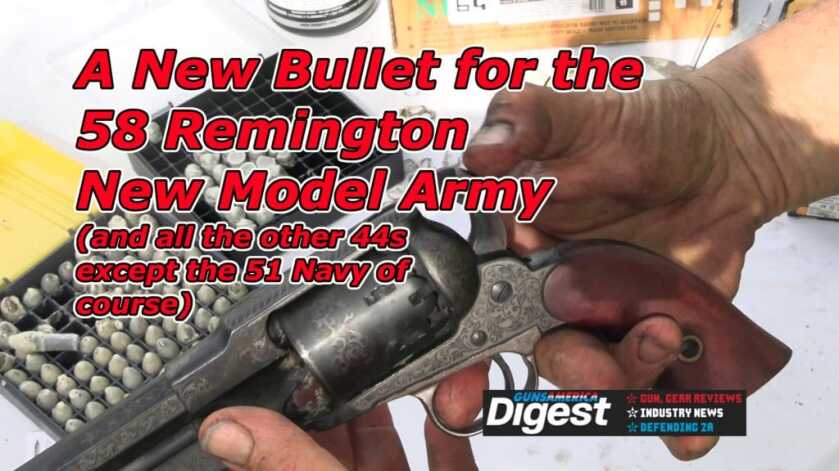
45-200s Bullet Mold – at Accurate Molds
200 Grain Semi-Wadcutter – at cartridgekits.com
Performance is not something most people attribute to black powder firearms. They are a novelty. Maybe you can take an extra deer, and the history if the Civil War guns is pretty cool. But an effective weapon? As effective as your plastic semi-auto pistol? Well probably not.
As a generalization I would probably agree. Pop pop pop pop pop (with a lot more pops) is a great attribute of high-cap semi-autos. But as I have explained many times in this Black Powder Project, there is no reason to not have a gun that nobody knows about as a backup just in case.
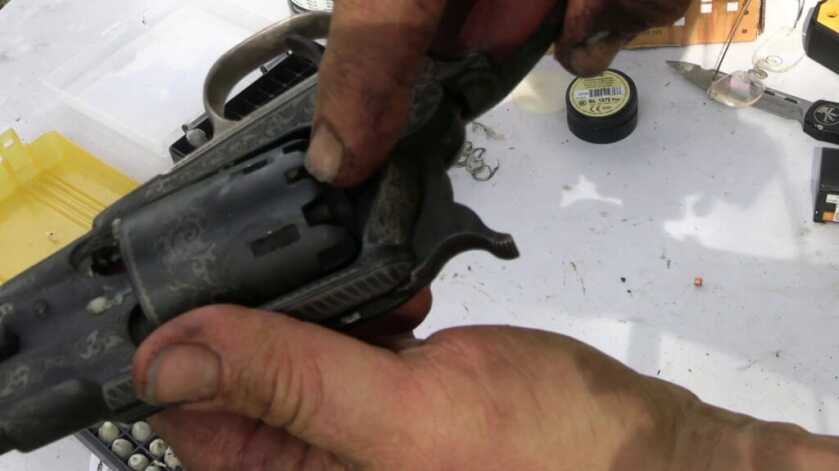
And for that, there is no comparison to the ’58 Remington, otherwise known as the New Model Army. I actually have a “real one” from the Civil War that we will probably compare with these new fangled copies at some point. But man oh man are the copies good. I am partial to the Pietta, as I have found it to be more durable for a lot of shooting. Right now they are somewhat scarce, but GunsAmerica usually has several listed, and if you look around regular retail, you’ll find some. The usual suspects are also getting them in regularly it seems. And even some of the pricey ones like the one in the video are still coming up with spotty availability, but are much more pricey than they were a year ago when you find them.
The problem with the Remmy, and really all 44s in black powder pistols, is that the traditional projectile, the roundball, is extremely limited. I’m not going to let you shoot at me at 100 yards with one, but the ballistics are not impressive at the speeds where you shoot them without damaging your gun.
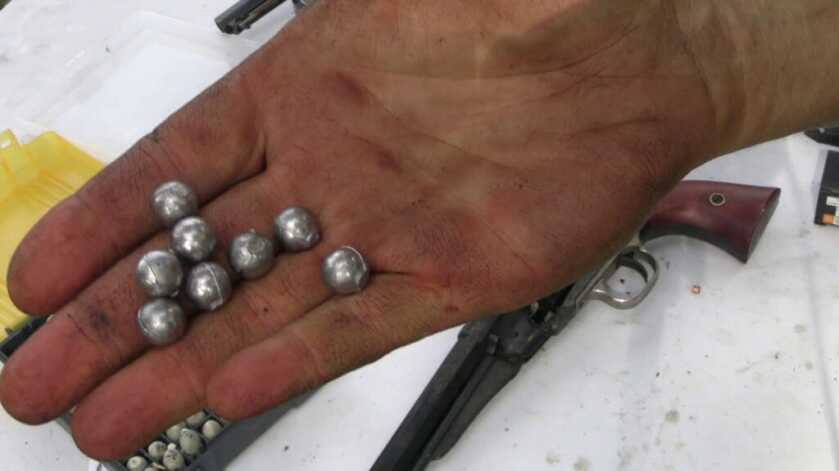
Blowing the gun up isn’t the problem. You could stuff the chambers with black powder and substitutes and fire it, and these guns would never blow up. The problem is barrel leading. You have to use a pure lead projectile in all of these guns because you shave the edges off as you press it in with the loading lever.
Over 1,000 feet per second or so, a pure lead bullet is going to start to leave some lead in your bore, and it is a huge pain to get it out. So it is kind of a catch-22. A little antimony would make the bullet handle higher velocity, but it would be too difficult to shave and seat.
That is why most enthusiasts of these guns shoot a conical projectile of some kind. With a heavier bullet, you get much more terminal energy clocking at the same speed. They just hit harder, penetrate better, and if there is such a thing as knock down power in a handgun (questionable), a heavier bullet is going to achieve that. It will not shine in foot pound calculations, because velocity is squared (multiplied times itself) in that equation, but you’ll see in any kind of penetration test that it is night and day with a roundball.
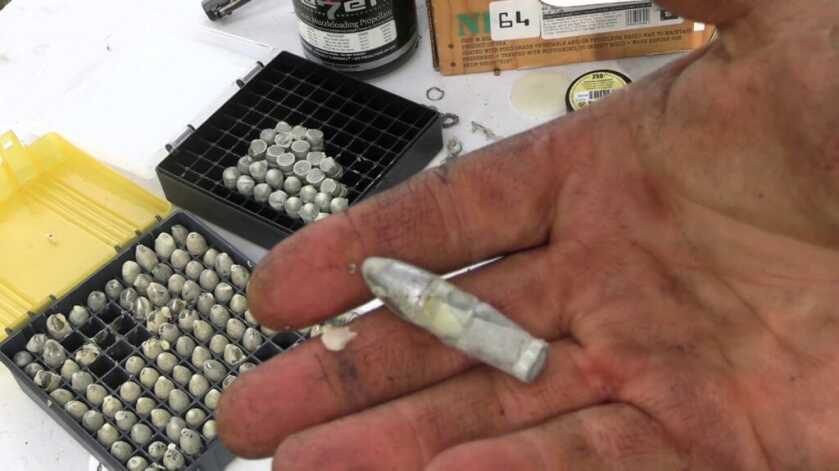
I would say the most common and popular conical in these guns right now is the 215 grain Johnson & Dow bullet that originated in Civil War contracts. The only source for those bullet molds is Eras Gone Bullets, and they are not always available. Right now as I write this they are. You can also buy the bullets themselves from Star & Bullock Hardware, at https://cartridgekits.com/.
That J&D is really great in most cases, but it does not fit easily under the loading lever on the ’58 Remington Piettas, so you end up having to bend the tip a bit to get it to clear. For me there is no benefit in shooting these guns with a “historically correct” bullet. I look at them as self defense weapons. I honestly couldn’t care less about the historical aspect of these modern replicas. For a while now I have been looking for a good bullet for these guns that is easy to load, and hits hard.
I found it at Accurate Molds. For now the bullet is called the 45-200S, and I am hoping you guys will comment and help me come up with an official name for it. You can buy the mold from them in a single to five cavity mold made from aluminum, brass or iron, and ranging in price from $95 to about $240.
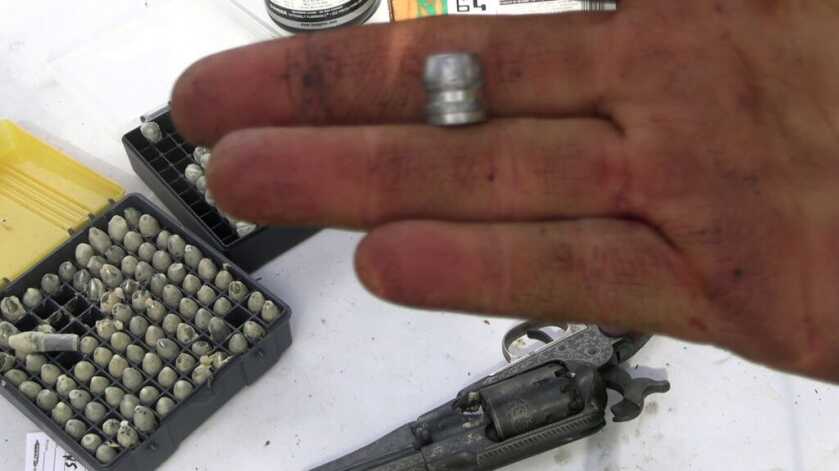
The key to this bullet is essentially the same thing that makes the J&D so good. It has an undersized heel that fits down into the chamber, which centers the bullet perfectly. The outside diameter of the bullet is slightly different, .455 on this bullet compared to the .260 on the J&D, but they both shave a nice ring on the current Pietta and Uberti ’58 Remingtons, as well as the 1860 Colt Army. You cannot use these or the J&D in the 1851 Colt Navy at all. They do not clear the loading gate.

I hope that the video I did with this article will dispel some myths out there in cap ‘n ball land. The first is that roundballs are the most accurate of all the bullets you can use. This may be true in some guns, with some loads at some velocities, but but in true self defense loads it is absolutely false. Generally the most accurate load in any gun is going to be on the weaker side of the spectrum. And my guess is that this myth started out with SASS guys who shoot mousefart loads at steel plates ten feet away for their matches. They have no reason to try a conical, so why not say they are inferior?

In my fairly informal shooting, leaning against a tree, both of the conicals performed much superior to the roundball at 10 yards, which is the outside of normal street gunfight range. Shooting one handed, I obviously pulled some shots on all of the bullets, but in general this current production un-altered off the shelf Pietta performed almost as well as I can shoot at that distance under the same conditions with a modern semi-auto.
The new bullet actually performed better, and that was over two cylinders, not one, which should bring the deviation out.
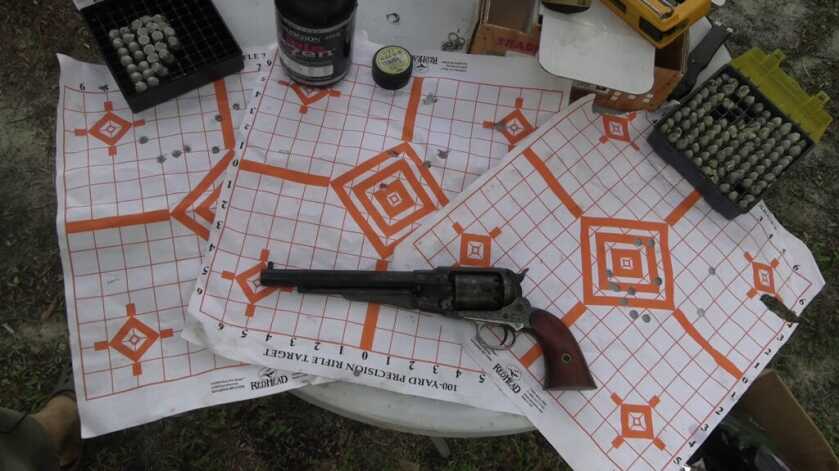
My velocities were tame on all of the rounds, generally under 1,100 feet per second because I don’t like to go into supersonic territory with these guns. I am working on a possible solution to that, because there is over an 1/8th of an inch of space left for more powder, and these are not the limits of what these guns can do by any stretch. Unfortunately, because no matter what these bullets shave, that means lead touches the sides of the barrel, and if you go supersonic they will lead the bore.
I actually give the J&D bullets more than a fair chance to best this new bullet, because they were loaded with Pyrodex RS, and the velocities were generally under 950 fps. Those were the first paper cartridges I loaded when I first got my kit from cartridgekits.com. I only had some RS on hand. That means rifle/shotgun and is a courser granulation than you would use for pistols. It is the equivalent of FFG black powder. For the new bullet I used Hodgdon Triple Se7en in the FFFG granulation, which is for pistols.
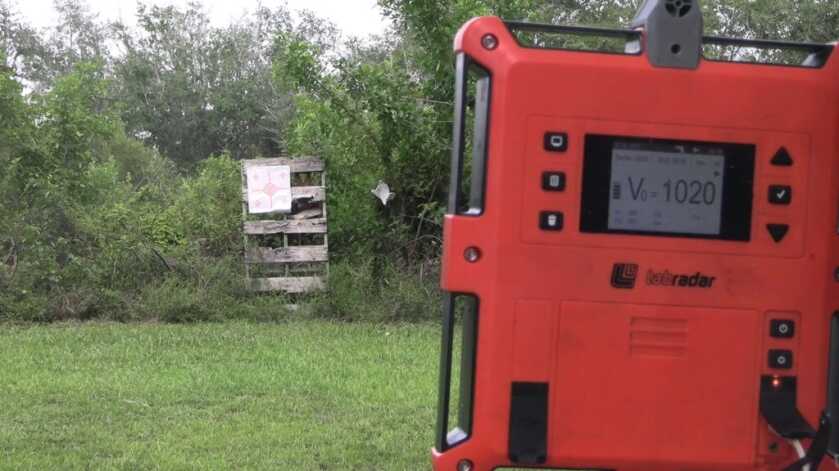
None of my charges were weighed. I used the dipper method for my paper cartridges that I outline in my video on how to make those little buggers. For conicals you use a full scoop where you can see the outside rim of the dipper, and for roundballs you heap it, covering the ring. This is a fairly rough estimation, and one of the reasons you will see fluctuations of over 50 fps shot to shot. With carefully weighed charges these guns can do a lot better with accuracy, even at full snot loads.
The second myth that I hope people understand I busted is the pointy bullet myth. I have explained in this column time and again that pointy bullets don’t matter at handgun ranges. For one, the base of the bullet, not the nose, controls accuracy shot to shot. High end meticulous bullet casters who make large lead bullets for long range black powder actually put a divet in the bullet mold near the point, so that there is a visible index mark on the bullet that can be lined up in the case and with the bore to reduce inconsistencies shot to shot. The nose does not matter on any heavy bullet at any distance. But with heavy bullets like these, roughly 4 times the weight of a bullet for an AR, irrelevant not even a question. The most accurate revolver bullets have always been “wadcutters” or semi-wadcutters, which have a flat tip.

I don’t expect that the proof here will change anything. There is a actually a popular Youtuber who covers “guns of the west” who even made a video telling people to change the loading lever on their cap ‘n ball revolvers so that it did not flatten the tip of the J&D bullet. The internet has unfortunately given a very loud voice to a lot of people who just don’t know what they are doing.
The new bullet has another side benefit over the J&D if you are making a lot of paper cartridges, and using a dip lube as I show in the video. It is flat, so after you dip, you can put it down on a piece of cardboard face up to dry. You can’t do this with the pointy bullets. You have to put them down in your loading trays, and they drip all over the place and make a mess. As someone who has loaded these cartridges for a 12 stage SASS match, plus side matches, it saves a lot of hassle and mess.
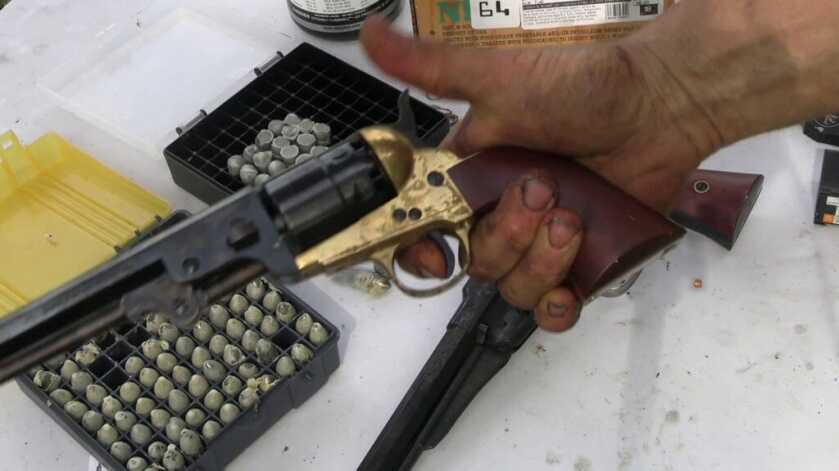
So maybe you guys can come up with a better name than the Dripless Thumper. I am kind of at a loss. But for me it’s a great bullet that seems to check all the right boxes, except that darn ’51 Navy.

Great write up on an excellent bullet. Rodwha (the original designer) would be proud. I do have a couple of points I’d like to share. Both relate to your leading problems. First of all, supersonic velocities do not by themselves create a leading problem. Some guns will and some guns won’t, and the severity will vary as well… I have many many replicas and originals and have fired hundreds of pounds of powder through them over 60 years and counting.
There are a few contributing factors, bore condition, chamber size as compared to bore size, forcing cone dimensions and angle, lube quantity and quality, protection of the bullet base, and I’m sure there are other factors I haven’t considered.
In the main, a clean and very smooth bore free of pits and erosion with chambers at least .001” over the groove dimension, a forcing cone sized such that a bullet will fit less than half its length into the cone, an over powder card wad (.452x.030” works in most factory chambers. I use .460”x.030 cards in most of my pistols which are reamed to .456”) and last but not least lubed with any concoction you prefer as long as it contains beeswax, vegetable oil of your choosing and Stihl HP synthetic lube. 2 ounces per pound of lube will prevent leading in almost every instance. I’ve used it in .45 and .50 rifles which push pure lead over 1200 fps and alloys over 1400 fps without any leading. Simple, proper lube, proper fit of projectile and bore, clean smooth bore surfaces, protect the base of the bullets and a layer of proper lube between bullet and bore and you will eliminate leading in your revolvers. Happy hunting…
I have followed your black powder series with great interest. I do not mold bullets myself, nor do I have a sizer, but purchased some from S&B Hwd. Unlike what you describe as a .455 dimension, those I received were .460-.461. I too thought the Powder, Inc Eze-Loader would work, but it didn’t. Like you, I hammered my first cylinder of these in, finishing them off using a hammer and my brass range rod.
As I reported to S&B Hwd, the results were very good accuracy, easy shooting with the Cartridge Kit scoop of 30 gr Triple 7, and a consistent 1024 fps velocity, definitely in the .45 ACP + P range.
This may very well be the top bullet for the 1858 Rem .44, but shouldn’t they really be sized at .455 or close to that for easier loading? Hammering the bullet into the cylinder might be ok for one or two cylinders to try a bullet, but isn’t something practical for the field, the range, or self defense. Why not insist on these bullets be sized smaller so they can be loaded using the Rem’s loading arm?
A good design, but wrong size. Great articles in this series.
really don’t like to see one pushing the max from a brass frame blackpowder revolver …… in early 70’s shot a ASM enough the arbor would no longer tighten in the frame… but thats just me, your milage may vary.
Yea sometimes the brass frame guns get squirly because the pin gets cockeyed, but you have to shoot them a lot.
It should be called the 45 Midnite. As in lights out and black powder.
You are exposing your ignorance of the subject, which is typical of a lot of new time writers, in that you say the bullet shape does not matter.
If you ever had any experience with Arcane bullets you would not have said such a thing. However, I know of no source for them for use in black powder firearms. It is an interesting idea though.
An Arcane bullet would necessarily blow a serious hole in any physical body (living tissue) it hit.
Do your homework before putting your “beliefs” on paper for people less informed to learn from. Other than that I found your article informative. Thank-you.
It’s not a belief. What you have is a belief. Any long distance shooter will tell you that the base of the bullet is what controls accuracy, and you could easily research that yourself. On a heavy bullet especially the nose of the bullet has no effect whatsoever. And effective handgun distances there would be no difference anyway.
Love your articles! I just have to disagree with you about one point. I shoot the 200+ grain conicals with the flat meplat around 1000fps using 777 for hunting. They penetrate beautifully; however, I’d use the round balls for personal defense because they deform better and hit harder.
Because you have dropped people in gunfights lol? From where would you surmise that?
Empirical data on soft lead performance or just offering an opinion. Why are you always an ass. You should just stay locked in your compound in Florida, and prep for doomsday.
Well they both would be soft lead. And yes, I have very little tolerance for people who talk out of their ass just to feel like they have some self worth. Self worth comes from within.
Then again, I’ve read that Elmer Keith talked to a civil War veteran who told him the conicals were great for slaughtering cattle, but the round balls were better for shooting men.
If you want to get higher velocity without leading, try a gas checked bullet. Gas Checks are a method of enhancing the bullet performance by sealing the base of the bullet against gas blow-by and shielding the lead from the high temperatures generated by the gunpowder. The use of a gas check inhibits the buildup of lead in the barrel and improves accuracy. It has been a generally accepted practice to use a Gas Check on bullets above 1,400 fps.
You can’t compress a gas check bullet down into the cylinder.